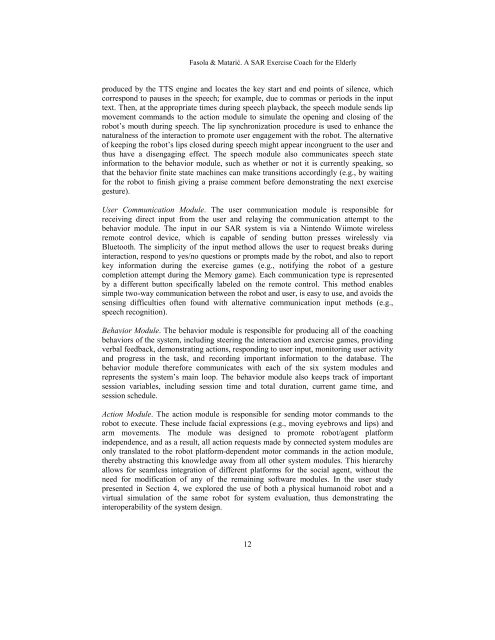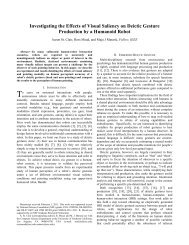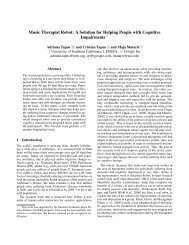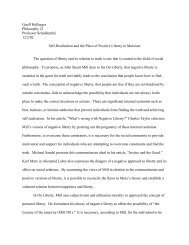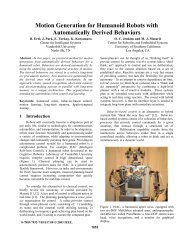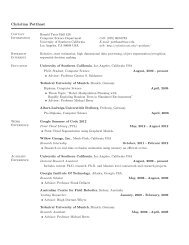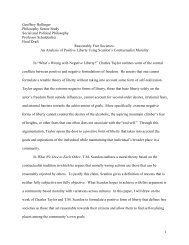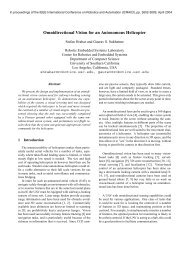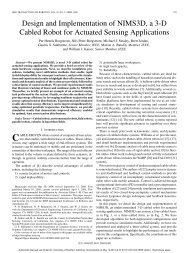Fasola & Matarić. A SAR <strong>Exercise</strong> <strong>Coach</strong> <strong>for</strong> <strong>the</strong> <strong>Elderly</strong>produced by <strong>the</strong> TTS engine and locates <strong>the</strong> key start and end points of silence, whichcorrespond to pauses in <strong>the</strong> speech; <strong>for</strong> example, due to commas or periods in <strong>the</strong> inputtext. Then, at <strong>the</strong> appropriate times during speech playback, <strong>the</strong> speech module sends lipmovement commands to <strong>the</strong> action module to simulate <strong>the</strong> opening and closing of <strong>the</strong>robot’s mouth during speech. The lip synchronization procedure is used to enhance <strong>the</strong>naturalness of <strong>the</strong> interaction to promote user engagement with <strong>the</strong> robot. The alternativeof keeping <strong>the</strong> robot’s lips closed during speech might appear incongruent to <strong>the</strong> user andthus have a disengaging effect. The speech module also communicates speech statein<strong>for</strong>mation to <strong>the</strong> behavior module, such as whe<strong>the</strong>r or not it is currently speaking, sothat <strong>the</strong> behavior finite state machines can make transitions accordingly (e.g., by waiting<strong>for</strong> <strong>the</strong> robot to finish giving a praise comment be<strong>for</strong>e demonstrating <strong>the</strong> next exercisegesture).User Communication Module. The user communication module is responsible <strong>for</strong>receiving direct input from <strong>the</strong> user and relaying <strong>the</strong> communication attempt to <strong>the</strong>behavior module. The input in our SAR system is via a Nintendo Wiimote wirelessremote control device, which is capable of sending button presses wirelessly viaBluetooth. The simplicity of <strong>the</strong> input method allows <strong>the</strong> user to request breaks duringinteraction, respond to yes/no questions or prompts made by <strong>the</strong> robot, and also to reportkey in<strong>for</strong>mation during <strong>the</strong> exercise games (e.g., notifying <strong>the</strong> robot of a gesturecompletion attempt during <strong>the</strong> Memory game). Each communication type is representedby a different button specifically labeled on <strong>the</strong> remote control. This method enablessimple two-way communication between <strong>the</strong> robot and user, is easy to use, and avoids <strong>the</strong>sensing difficulties often found with alternative communication input methods (e.g.,speech recognition).Behavior Module. The behavior module is responsible <strong>for</strong> producing all of <strong>the</strong> coachingbehaviors of <strong>the</strong> system, including steering <strong>the</strong> interaction and exercise games, providingverbal feedback, demonstrating actions, responding to user input, monitoring user activityand progress in <strong>the</strong> task, and recording important in<strong>for</strong>mation to <strong>the</strong> database. Thebehavior module <strong>the</strong>re<strong>for</strong>e communicates with each of <strong>the</strong> six system modules andrepresents <strong>the</strong> system’s main loop. The behavior module also keeps track of importantsession variables, including session time and total duration, current game time, andsession schedule.Action Module. The action module is responsible <strong>for</strong> sending motor commands to <strong>the</strong>robot to execute. These include facial expressions (e.g., moving eyebrows and lips) andarm movements. The module was designed to promote robot/agent plat<strong>for</strong>mindependence, and as a result, all action requests made by connected system modules areonly translated to <strong>the</strong> robot plat<strong>for</strong>m-dependent motor commands in <strong>the</strong> action module,<strong>the</strong>reby abstracting this knowledge away from all o<strong>the</strong>r system modules. This hierarchyallows <strong>for</strong> seamless integration of different plat<strong>for</strong>ms <strong>for</strong> <strong>the</strong> social agent, without <strong>the</strong>need <strong>for</strong> modification of any of <strong>the</strong> remaining software modules. In <strong>the</strong> user studypresented in Section 4, we explored <strong>the</strong> use of both a physical humanoid robot and avirtual simulation of <strong>the</strong> same robot <strong>for</strong> system evaluation, thus demonstrating <strong>the</strong>interoperability of <strong>the</strong> system design.12
Fasola & Matarić. A SAR <strong>Exercise</strong> <strong>Coach</strong> <strong>for</strong> <strong>the</strong> <strong>Elderly</strong>Database Module. The database module is responsible <strong>for</strong> storing important user-relatedin<strong>for</strong>mation regarding task per<strong>for</strong>mance and progress, in addition to session history.Examples include <strong>the</strong> date and time of previous sessions, exercise per<strong>for</strong>mance in each of<strong>the</strong> exercise games, number of breaks taken, high scores, etc. This in<strong>for</strong>mation isavailable <strong>for</strong> retrieval during interaction by <strong>the</strong> behavior module, which uses <strong>the</strong>in<strong>for</strong>mation to implement continuity behaviors and <strong>for</strong> reporting user per<strong>for</strong>mance andprogress. The database in<strong>for</strong>mation is also useful <strong>for</strong> obtaining quantitative metrics ofuser per<strong>for</strong>mance <strong>for</strong> post-session/user study system evaluation.3.5 User Activity RecognitionIn order to monitor user per<strong>for</strong>mance and provide accurate feedback during <strong>the</strong> exerciseroutines, <strong>the</strong> robot must be able to recognize <strong>the</strong> user’s arm gestures. To accomplish this,we developed a vision algorithm that recognizes <strong>the</strong> user’s arm gestures/poses in realtime, with minimal constraints on <strong>the</strong> surrounding environment and <strong>the</strong> user.Several different approaches have been developed to accomplish tracking of humanmotions, both in 2D and 3D, including skeletonization methods (Fujiyoshi & Lipton,1998; Jenkins, Chu, & Matarić, 2004), gesture recognition using probabilistic methods(Waldherr, Thrun, Romero, & Margaritis, 1998), and color-based tracking (Wren,Azarbayejani, Darrell, & Pentland, 1997), among o<strong>the</strong>rs. We opted to create an arm poserecognition system that takes advantage of our simplified exercise setup in order toachieve real-time results without imposing any markers on <strong>the</strong> user.To simplify <strong>the</strong> visual recognition of <strong>the</strong> user, a black curtain was used to provide astatic and contrasting background <strong>for</strong> fast segmentation of <strong>the</strong> user’s head and hands, <strong>the</strong>most important features of <strong>the</strong> arm pose recognition task, independent of <strong>the</strong> user’s skintone. The arm pose recognition algorithm consists of <strong>the</strong> following four major steps:1) Create segmented image: The original grayscale camera frame is converted into ablack/white image by applying a single threshold over <strong>the</strong> image. All pixels below <strong>the</strong>threshold are set to black, and <strong>the</strong> rest to white. The threshold is set by <strong>the</strong> experimenterto appropriately segment out <strong>the</strong> user from <strong>the</strong> background, accounting <strong>for</strong> <strong>the</strong> specificlighting of <strong>the</strong> environment. Figure 3(a) shows an original grayscale image captured from<strong>the</strong> camera, with <strong>the</strong> segmented image shown in Figure 3(b).2) Detect <strong>the</strong> user’s face: The OpenCV frontal face detector is used to determine <strong>the</strong>location and size of <strong>the</strong> user’s face. With <strong>the</strong>se values, an estimate <strong>for</strong> <strong>the</strong> shoulderpositions on both sides of <strong>the</strong> body is made.3) Determine hand locations: The hand locations of <strong>the</strong> user are determined byexamining <strong>the</strong> extrema points of <strong>the</strong> body pixels (maximum/minimum white pixellocations along x and y directions away from body) inside <strong>the</strong> region above <strong>the</strong> chest lineand to <strong>the</strong> side of <strong>the</strong> face in <strong>the</strong> segmented image (subtracting <strong>the</strong> head and estimatedbody regions—represented by green and blue bounding boxes in Figure 3). The algorithmapplies a simple set of rules, or heuristics, to choose which extrema points correspond to<strong>the</strong> hand location <strong>for</strong> a given arm. For example, if <strong>the</strong> highest white pixel (body pixel) in<strong>the</strong> segmented image on <strong>the</strong> left side is fur<strong>the</strong>r than <strong>the</strong> approximate shoulder-to-<strong>for</strong>earmdistance, <strong>the</strong>n that is <strong>the</strong> left hand location.These extrema point heuristics are valid <strong>for</strong> this domain, as <strong>the</strong> silhouette of a persondemonstrating planar arm movements (i.e., only two degrees of freedom) will alwaysfeature at least one of <strong>the</strong>se extrema points at each of <strong>the</strong> hand locations, due to <strong>the</strong>geometric properties of planar two-link manipulators. This planar two-link assumptionthus validates <strong>the</strong> use of extrema point heuristics per<strong>for</strong>med on a binary segmentation of<strong>the</strong> image (approximated silhouette) to detect <strong>the</strong> hand locations of <strong>the</strong> user.13


